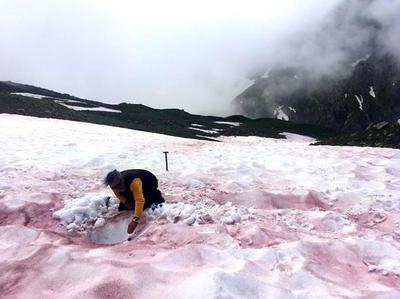A scientist samples snow covered red microalgae, a phenomenon known as "glacier blood." Jean-Gabriel VALAY/JARDIN DU LAUTARET/UGA/CNRS
A consortium of French laboratories, the ALPALGA project, has set out to study the little understood communities of microalgae that live in mountains, including some that turn snow orange or red, a phenomenon known as “glacier blood.” Scientists believe that climate change may be fueling blooms of red microalgae in the Alps.
Eric Maréchal, a coordinator at the ALPALGA project, told Live Science that people who frequent the Alps are seeing more red snow, and he recalled eyeing huge swaths of “glacier blood” on a 2019 hike. “Everywhere I put my eyes, it was red,” he said. “We walked all day, seeing surfaces stained in red.”
Scientists believe that rising levels of carbon dioxide may be fueling the growth of the photosynthesizing snow-borne microalgae. Likewise, changes in wind and snowfall may be delivering additional nutrients to algae, leading to the spread of “glacier blood.” However, researchers have yet to quantify changes in algae over time.
In an initial study, published in the journal Frontiers in Plant Science, researchers mapped the distribution of several species of snow-borne microalgae in the French Alps. They determined that the green microalgae Symbiochloris live only below 1500 meters, while the genus Sanguina, which turns snow red, are found only 2,000 meters above sea level and higher. These microalgae produce carotenoids — the same pigments that turn pumpkins orange and tomatoes red — which act like antioxidants, offering some protection against ultraviolet light at high elevation. Understanding where Sanguina algae make their home will help scientists track algal blooms, determine their causes, and monitor their effects.
Microalgae are the base of the mountain food chain, and their growth could send ripples throughout the ecosystem. There is also some evidence that algal blooms are hastening snowmelt, as red-colored snow absorbs more heat than white snow, meaning the growth of “glacier blood” could exacerbate the impacts of climate change.



